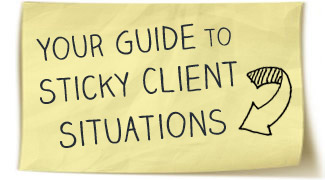
In the rush to make ends meet as a freelancer or small business owner, it can be easy to bend over backwards for clients. After all, they’re putting food on your table!
But when you’re getting phone calls on weekends and unreasonable requests that stress you out, it’s time to put your foot down.
In an ideal world, you’ve set up boundaries from the get go and clearly articulated them to your client in a welcoming email or your initial phone conversation. But even if you’ve been working with a client for a while you can still rein them in. Just be open and honest about what’s working and what’s not.
A good client will honor your boundaries, and respect you for having them. If you get major push back when trying to set limits, that’s an excellent sign it’s time to move on and find a better client who will give you the respect you deserve.
Here are the conversations to have:
Define the Relationship
Make your boundaries clear from day one. If you have a welcoming email or packet as part of your client intake process, make sure it details things like:
- How long you’ll take to respond to emails
- When you’re available to chat via IM or phone
- What your working hours are
- What’s the best way to contact you
- Whether or not you accept rush work, and what additional fees apply
You can also include a FAQ page on your website, and refer clients to that during your first conversations. Start out on the right foot, and be consistent – if you begin your relationship by answering emails the moment they arrive, your client will start to worry if you suddenly wait until the next day to respond.
Define the Project and Deadlines
We’ve all gotten involved with projects that went on way too long – or which kept mutating or growing beyond the original agreement. The easiest way to combat this is to be thorough in your proposal and contract.
List all aspects of what you will and won’t do, and be sure to include a line in the contract stating that anything above and beyond will be billed at an hourly rate. That way when a client asks you to add on one small extra thing, you can respond by pointing to your contract, and quote them a price.
If you can, set deadlines and make them part of your payment schedule. For a long project, it can help to set milestones and bill when you reach them – when you turn in your portion, or finish revisions, for example. If you’ve done your work you should get paid, regardless of whether the client has fallen behind on their part.
You should also agree on how you’ll be checking in – will you email weekly? Daily? If a client’s random piecemeal questions throughout the week are eating up too much time, try setting a recurring weekly time where you can touch base over the phone or skype.
Define Your Working Hours
When you’re self-employed you may work odd hours – particularly if you’re juggling your work in between daycare, babysitters, and nap times. But just because you may be checking email long after the kids go to bed doesn’t mean you need to be available at all hours of the day.
How often have you taken on rush client work because you felt like you had to? A Friday afternoon assignment that needs to be turned around by Monday morning, for example.
Post your hours on your website. Tell your clients when you are and aren’t available, and stick to it. If you don’t work on weekends, politely tell that to the Friday afternoon rush client, and offer to start work first thing Monday morning if your schedule allows.
Rush work should ALWAYS command a higher fee for the inconvenience it causes to your schedule. If possible, include a rush fee clause in your contract. But even if it’s not written down, it’s a pretty standard practice for freelancers, and good clients will understand.
Discourage After Hours Communication
Have you got a client that calls, texts, or emails at all hours, expecting you to always be available? It’s time to cut that off. This client would never call the bank at 7pm and expect a live response, and just because you’re a freelancer doesn’t mean things should be any different.
Use a dedicated work phone, and turn it off when work hours are through. List your business hours in your voice mail message, so clients can know when to expect a response.
If a separate phone isn’t an option, get a Google Voice number to use for your business. Calls to this number will be forwarded to your phone, and you can set all sorts of great options for screening. There’s even a “Do Not Disturb” feature that sends calls straight to voicemail after hours.
If you are answering emails at 2am or on weekends (aren’t we all?), use an email scheduler program to send out your reply during business hours.
Have you ever had to rein in an unruly client? What strategies did you use?





